IBM FlashSystem 820 testing
With the current level of IT industry development, server and storage system performance is becoming an increasingly critical factor. Customers are ready to invest more and more money to achieve maximum performance. In most cases, the use of flash-based drives can significantly increase the performance of high-load applications such as databases, OLTP, OLAP, etc.
In the middle of this year, IBM introduced a line of FlashSystem which includes products using flash memory. The lineup includes 4 models: FlashSystem 710/720, 810/820 . The 710/720 uses SLC, and the 810/820 has more reliable eMLC memory. Distracted from the study, beloved by us, PCIe SSD , at the disposal of our test lab for a short time turned out to be a demo copy of the FlashSystem 820 model, with a volume of 10 TB for a more detailed acquaintance.


')
The architecture of this series of storage systems does not have a single point of failure, due to duplication of the main components (PSU, built-in battery, controllers), as well as hot-swappable flash modules. Performance and reliability are the main reasons for using eMLC memory instead of the usual MLC in IBM products. Reliability of data storage is also ensured by IBM Variable Stripe RAID technology.
Testbed configuration:
Platform - IBM X3650 M4
Processor - Xeon E2603
Memory - 8 GB
Hard drives - 3xSAS 146GB 10k
We tested the storage using our standard set of test packets, which we have repeatedly used in our articles.
ATTO Disk Benchmark
We carried out testing with parameters:
Total Length = 256 Mb
Queue Depth = 2-10
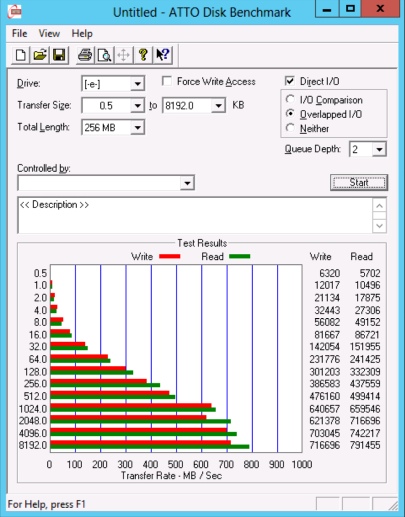
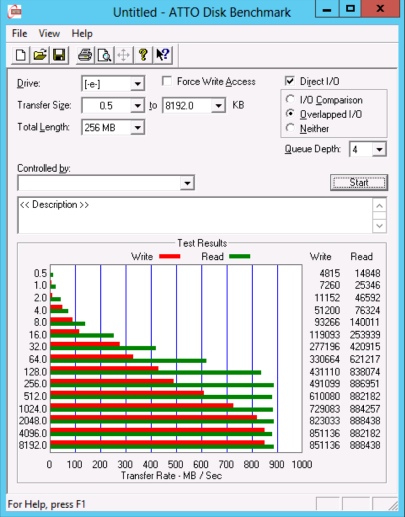

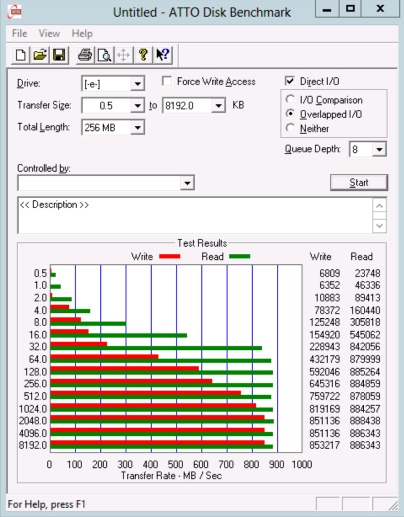
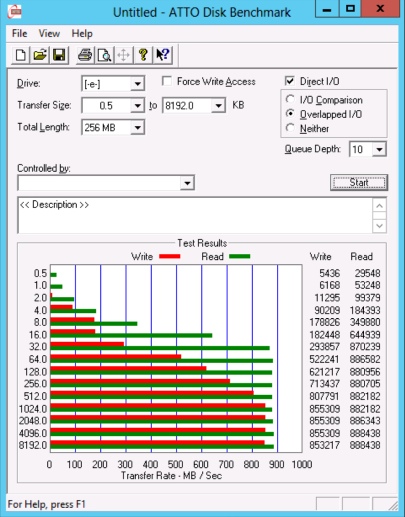
AS SSD Benchmark
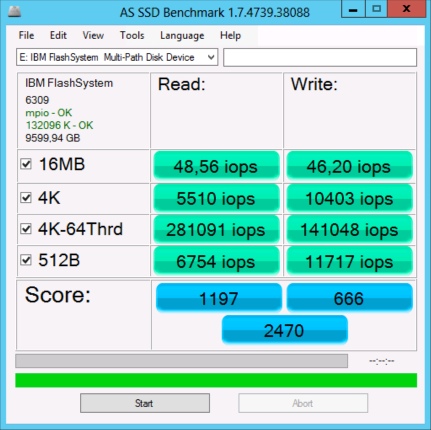

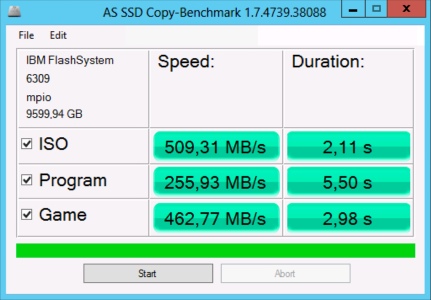
Crystaldiskmark

Iometer
For testing, a set of patterns that we have already tested was chosen:
As results, we chose the maximum values obtained during testing.

Fio

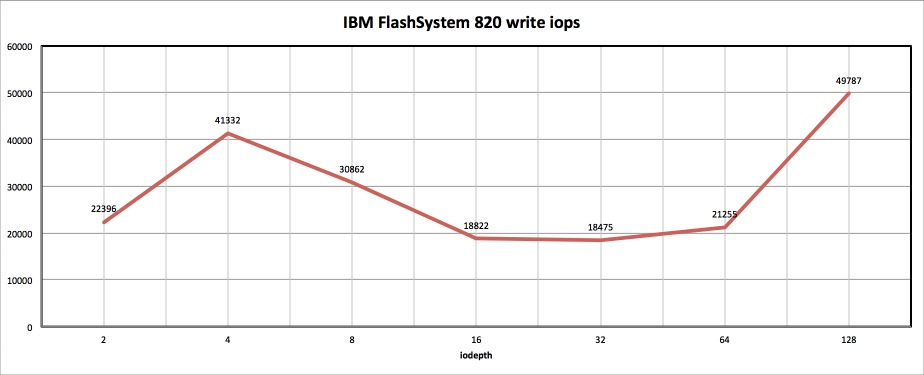
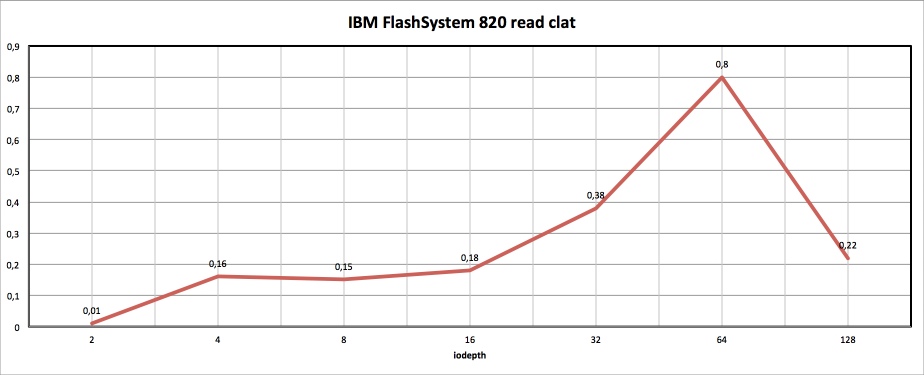
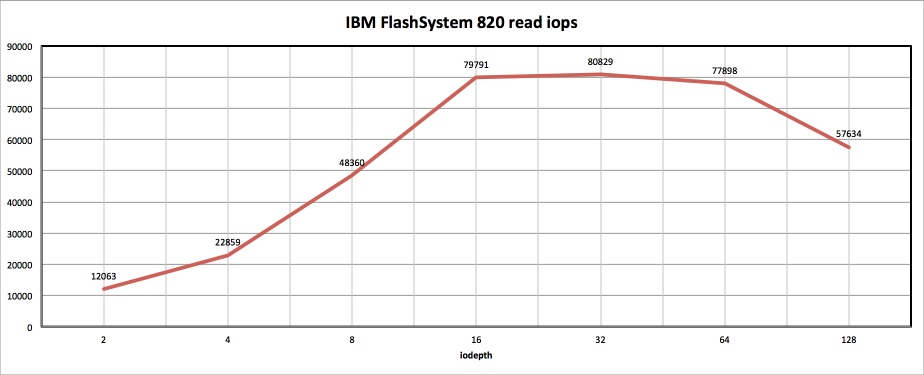
For those who want to see all the numbers with their own eyes, I suggest a test log:
iodepth = 2
iodepth = 4
iodepth = 8
iodepth = 16
iodepth = 32
iodepth = 64
iodepth = 128
The test results of the SQLIO package this time we decided not to publish, due to the fact that we got too low performance, and no matter how much we played with the test run parameters (the number of threads, queries), we could not get reliable information. Unfortunately, the storage system stayed with us for a very limited amount of time and we could not study in detail what was the problem after all. I hope when she gets into our hands again, we can fill this gap.
Flash memory is increasingly entering the corporate market. Now they already exist in various variations, and as SAS disks, as PCIe SSD drives, as cache in storage etc. Flash memory delivers outstanding performance, extremely low latency and is an excellent option for customers who value storage performance combined with high volume.
Korp author
In the middle of this year, IBM introduced a line of FlashSystem which includes products using flash memory. The lineup includes 4 models: FlashSystem 710/720, 810/820 . The 710/720 uses SLC, and the 810/820 has more reliable eMLC memory. Distracted from the study, beloved by us, PCIe SSD , at the disposal of our test lab for a short time turned out to be a demo copy of the FlashSystem 820 model, with a volume of 10 TB for a more detailed acquaintance.


')
Features:
- The IBM Variable Stripe Redundant Array of Independent Disks (RAID) technology allows you to reduce the number of system interruptions without sacrificing performance or available capacity
- Accelerated decision making across multiple applications, including databases for online transaction processing (OLTP) and online data analysis (OLAP)
- 1U form factor storage systems with extremely high installation density improve IT infrastructure efficiency and throughput, as well as the number of I / O operations per second without sacrificing responsiveness
- Eco-friendly data storage systems that provide fast data access with low power consumption offer tremendous benefits.
- Start getting a return on investment almost immediately thanks to the rapid deployment of the system.
- The ability to use single-layer flash memory (SLC) or enterprise-class modules with multi-level memory cells (eMLC)
- Allows organizations to quickly analyze data using traditional tools as well as using new technologies developed to analyze Big Data.
- Scalable storage devices save space and energy.
The architecture of this series of storage systems does not have a single point of failure, due to duplication of the main components (PSU, built-in battery, controllers), as well as hot-swappable flash modules. Performance and reliability are the main reasons for using eMLC memory instead of the usual MLC in IBM products. Reliability of data storage is also ensured by IBM Variable Stripe RAID technology.
IBM Variable Stripe RAID (VSR)
- Patented technology allows you to change the size of stripe in RAID
- If one chip on a chip fails, the chip is bypassed, data is distributed across the remaining chips.
- VSR reduces the number of services required when a flash memory fails.
Testbed configuration:
Platform - IBM X3650 M4
Processor - Xeon E2603
Memory - 8 GB
Hard drives - 3xSAS 146GB 10k
We tested the storage using our standard set of test packets, which we have repeatedly used in our articles.
ATTO Disk Benchmark
We carried out testing with parameters:
Total Length = 256 Mb
Queue Depth = 2-10





AS SSD Benchmark



Crystaldiskmark

Iometer
For testing, a set of patterns that we have already tested was chosen:
- Database
- File server
- Workstation
- Webserver
As results, we chose the maximum values obtained during testing.

Fio




For those who want to see all the numbers with their own eyes, I suggest a test log:
iodepth = 2
iodepth = 4
iodepth = 8
iodepth = 16
iodepth = 32
iodepth = 64
iodepth = 128
The test results of the SQLIO package this time we decided not to publish, due to the fact that we got too low performance, and no matter how much we played with the test run parameters (the number of threads, queries), we could not get reliable information. Unfortunately, the storage system stayed with us for a very limited amount of time and we could not study in detail what was the problem after all. I hope when she gets into our hands again, we can fill this gap.
Flash memory is increasingly entering the corporate market. Now they already exist in various variations, and as SAS disks, as PCIe SSD drives, as cache in storage etc. Flash memory delivers outstanding performance, extremely low latency and is an excellent option for customers who value storage performance combined with high volume.
Korp author
Source: https://habr.com/ru/post/207014/
All Articles